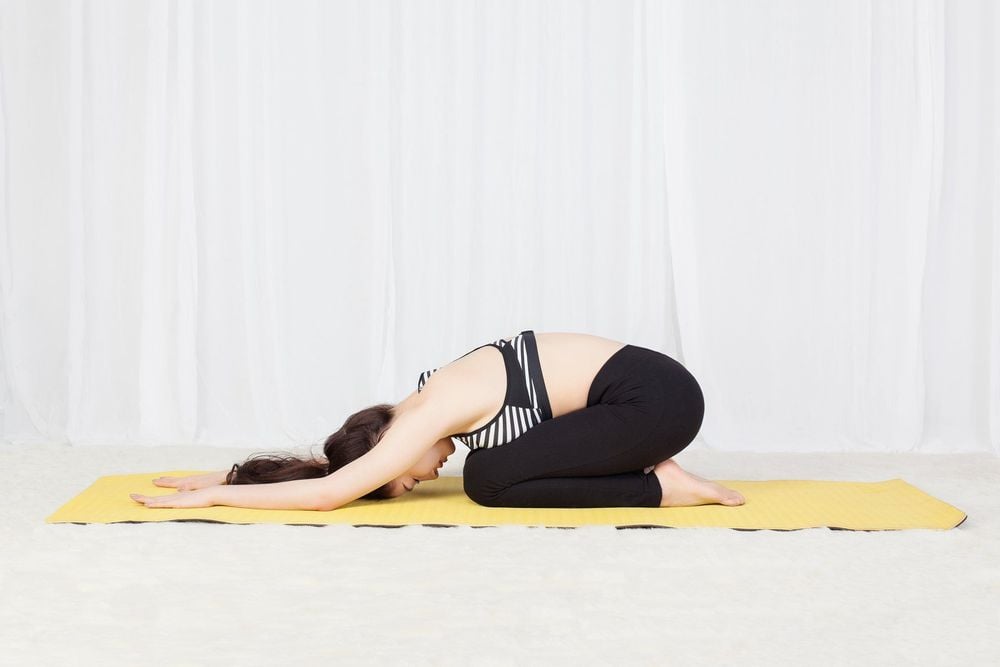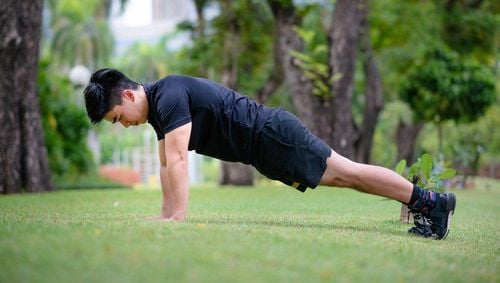This is an automatically translated article.
Shoulder pain or strain is a common problem, affecting about 18-26% of adults. To ease shoulder discomfort, patients can follow these 10 simple shoulder exercises below. These exercises help improve endurance, strength, increase shoulder flexibility and range of motion, bringing comfort to the patient.
1. 10 most effective shoulder exercises
1.1 Chest stretch This exercise increases the flexibility and range of motion of the shoulder joint and surrounding muscles. As a result, the shoulder muscles are more flexible. When performing this exercise, if you feel pain in your shoulder, you should lower your arm.
Exercise instructions are as follows:
Bring the right arm across the chest; Place the right arm in the crease of the left elbow (or use the left hand to pull the right arm); Remain in this position for up to 1 minute; Repeat with the left arm; Do each side 3-5 times. For a deeper stretch, the patient can raise the arm at shoulder height.
1.2 Neck Rotation This is a gentle exercise that helps relieve tension in the neck and shoulders for the patient.
Instructions to practice as follows:
Lower your chin in front of your chest. The patient will feel a stretch along the back of the neck; Gently tilt your head to the left to stretch the right shoulder; Remain in this position for up to 1 minute; Repeat on the opposite side; Do each side 3-5 times. To increase the intensity of this exercise:
The patient places one hand on the shoulder, one hand above the ear to guide the movement; Lower your chin in front of your chest. The patient will feel a stretch along the back of the neck; Gently tilt your head to the left to stretch the right shoulder; Hold this pose for up to 1 minute; Repeat on the opposite side; Do each side 3-5 times.

Xoay cổ giúp người bệnh giảm căng thẳng vùng cổ và vai
1.3 Open Chest This exercise helps promote shoulder flexibility and range of motion in the shoulders.
Instructions for exercise are as follows:
While standing, the patient puts his hands behind his back to hold the band, strap or towel; Move the shoulder blades towards each other, widening across the ribcage; Lift your chin, look up at the ceiling; Hold up to 30 seconds; Repeat the above movement 3-5 times. To open up more chest, place your hands closer together along the towel or strap.
1.4 Spine Roll Eagle Brace This exercise helps stretch the patient's shoulder muscles. If the arm position is uncomfortable, the patient can perform this exercise by holding opposite shoulders.
Instructions for exercise are as follows:
While sitting, the patient extends the arms to the sides; Cross your elbows in front of your body and place your right arm on top; Bend your elbows, placing the backs of your forearms and hands on top of each other; Bring your right hand around to touch your palms together; Hold the pose for 15 seconds; On exhalation, the patient curls the spine while pulling the elbows towards the chest; On inhalation, the patient opens the chest and raises the arms; Continue this movement for 1 minute; Repeat on the opposite side. 1.5 Back twisting This exercise helps to stretch the patient's shoulders and neck. When performing, the patient keeps the hips forward, twisting in the lower back. Exercise instructions are as follows:
The patient sits on a chair, thighs - knees perpendicular to the floor; Twist the upper body to the right, placing the back of the left hand on the thigh; Place the right hand down wherever the patient feels comfortable; Hold this pose for up to 30 seconds; Repeat with the opposite side; Do each side 3-5 times.

Xoay lưng vặn mình giúp kéo dài vai và cổ người bệnh
Instructions for exercise are as follows:
The patient stands upright, his left hand rests on the back of the chair; Let go of the right hand; Loop the right arm 5 times in each direction; Repeat on the opposite side; Do this exercise 2-3 times a day. 1.7 Doorway Shoulder Stretch This exercise opens the chest and strengthens the shoulders.
Instructions to practice as follows:
The patient stands in the doorway, resting elbows on the door, elbows and arms form a 90° angle; Step your right foot forward while pressing your palms against the sides of the door frame; Bend forward, holding the pose for up to 30 seconds; Bring right foot forward, do the same; Do each side 2-3 times. 1.8 Downward-Facing Dog This inversion strengthens and stretches the shoulder and back muscles.
Instructions to practice as follows:
Lie in a push-up position, use your arms to lift your hips up to the ceiling; Press your body weight evenly into your hands and feet, keeping your knees slightly bent; Keeping the spine straight, bring the head towards the legs so that the shoulders are bent over the head; Hold this position for up to 1 minute. 1.9 Baby's Pose This restorative pose relieves tension in the patient's back, shoulders, and neck. When performing, the practitioner should place a cushion under the forehead, chest or legs for support. Instructions are as follows:
From downward facing dog, bring the big toes together, bring the knees slightly wider than the hips; Place hips back on heels, arms extended in front of you; Bring your chest toward the floor to relax your spine and shoulders; Hold this position for up to 5 minutes.

Tư thế em bé giúp giảm căng thẳng ở vùng lưng, vai và cổ bệnh nhân
Instructions as follows:
Kneel, put your hands on the floor, arms parallel to each other, shoulder-width apart. Next, raise your right hand toward the ceiling, palm facing away from your body; Lower your arms, threading them over your chest to the left side of your body, palms facing the ceiling; Keep the right shoulder and arm balanced, not out of position; Keeping your left hand on the floor, lift toward the ceiling or bring your left hand to the inside of your right thigh; Hold this pose for up to 30 seconds; Relax in baby's pose before repeating this movement with the left side.
2. Note when performing shoulder pain exercises
You need to do exercises 3 - 6 times a week to relieve shoulder pain. Accordingly, you should start exercising for about 10 minutes and then gradually increase the duration when the patient feels stronger and more flexible;
While performing the exercises, the person should focus on relaxing and releasing any tension in the shoulders and anywhere else that is in a tight state. Stretch only to a comfortable level, do not exceed the limit. Patients should stop exercising if they feel too much pain.
SEE ALSO: Is electroacupuncture effective for neck pain?
3. Other remedies for shoulder pain relief
In addition to shoulder exercises, patients can try home remedies to relieve shoulder pain, effectively support the treatment of shoulder pathology. Measures include:
Follow the RICE method: Rest, cold compress and shoulder compressions. When possible, raise your shoulders above heart level. In addition, the patient can use a heating pad or soak in an Epsom salt water bath; To relieve shoulder pain, patients can take over-the-counter pain relievers such as acetaminophen or ibuprofen. In addition, natural pain relievers such as turmeric, cloves, ... are also a good choice. Patients can apply a mixture of menthol, Arnica cream, ... on the painful area several times per day; Regular massage and acupuncture treatments can relieve pain and bring balance to the body. Patients can try therapies such as chiropractic adjustment, osteopathy,... MORE: Electroacupuncture treatment for shoulder pain syndrome
4. How to prevent shoulder pain?
In addition to following the above shoulder exercises, patients can prevent shoulder pain by:
Practicing good body posture, avoiding bending or stooping when sitting, standing or when performing daily activities ; Pay attention to how you move your body throughout the day, adjusting as needed; Get more rest; Be careful when performing activities such as carrying heavy objects, bending forward,...; If playing sports that cause shoulder pain, the patient needs to ensure correct technique.

Nghỉ ngơi hợp lý và khoa học giúp ngăn ngừa tình trạng đau vai
5. When to see a doctor?
Patients should see a doctor or physiotherapist in the following cases:
Unable to move the shoulder, the pain worsens or the shoulder pain does not improve after 2 weeks of treatment; Severe pain in both shoulders or thighs, fever for patients.
Shoulder pain is common, but it is preventable and treatable. Performing the most effective shoulder exercises mentioned above on a regular basis can reduce and prevent shoulder pain.
Please dial HOTLINE for more information or register for an appointment HERE. Download MyVinmec app to make appointments faster and to manage your bookings easily.
Reference source: healthline.com












